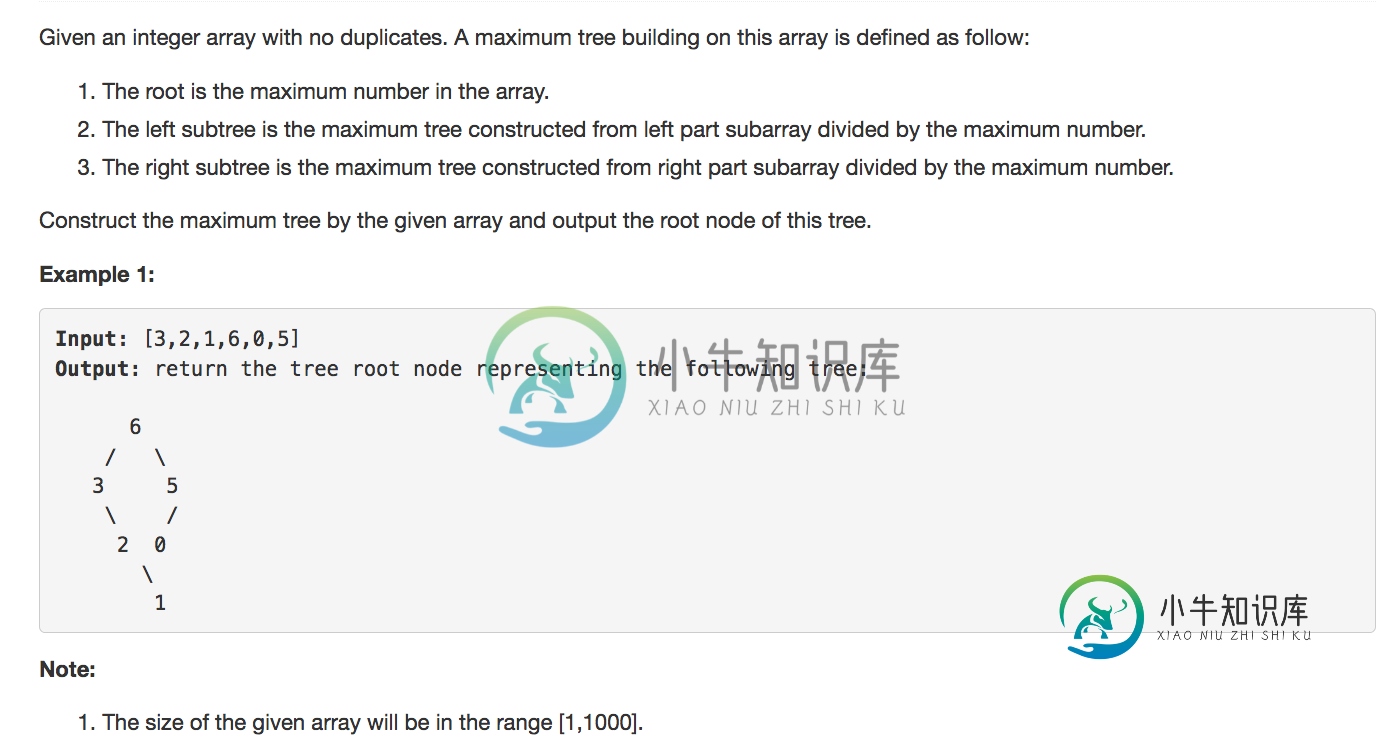我怎么走这个递归二叉树问题?

这是该问题的有效解决方案:
/**
* Definition for a binary tree node.
* public class TreeNode {
* int val;
* TreeNode left;
* TreeNode right;
* TreeNode(int x) { val = x; }
* }
*/
class Solution {
public TreeNode constructMaximumBinaryTree(int[] nums) {
return helper(nums, 0, nums.length-1);
}
public TreeNode helper(int[] nums, int low, int high){
if (high < low){ return null; }
//find max element's index
int maxIndex = getMaxIndex(nums, low, high);
//construct root node
TreeNode root = new TreeNode(nums[maxIndex]);
//generate left subtree from the left part of subarray
root.left = helper(nums, low, maxIndex-1);
//generate right sub tree from the right part of subarray
root.right = helper(nums, maxIndex+1, high);
return root;
}
public int getMaxIndex(int[] nums, int low, int high){
int maxIndex = low;
for (int i = low+1; i <= high; i++){
if (nums[i] > nums[maxIndex]){
maxIndex = i;
}
}
return maxIndex;
}
}
有人能帮我解释一下这个问题和所有的递归调用吗?现在我不明白解决方案是如何构建树节点的。我目前正在这样处理这个问题。
>
ConstructMaximumBinaryTree(int[]nums)
int maxIndex=getMaxIndex(nums,0,5)因此maxIndex=3。
树节点根=6。
root.left=helper(nums,0,2),因此maxIndex=0。
树节点根=3。
root.left=helper(nums,0,-1),它触发基大小写并返回null。
第6步之后我就迷路了。在步骤6返回null之后,我是否继续到root.right=helper(nums,maxindex+1,high)?如果是的话,maxIndex和high会是多少?接下来的步骤是什么?
共有1个答案
简单的答案是肯定的,您移动到root.right=helper(nums,maxIndex+1,high),其中maxIndex=0且high=2,因此root.right=helper(nums,1,2)。
这些步骤将是:
- ConstructMaximumBinaryTree(int[]nums)
- int maxIndex=getMaxIndex(nums,0,5)所以maxIndex=3。
- 树节点根=6。
- root.left=helper(nums,0,2)因此maxIndex=0。
- 树节点根=3。
- root.left=helper(nums,0,-1),它触发基本大小写并返回NULL。
- 对于root=3,我们继续使用右侧子树,因此root.right=helper(nums,1,2),maxIndex=1。
- 树节点根=2。
- root.left=helper(nums,1,0),它触发基本大小写并返回NULL。
- 对于root=2,我们继续使用右侧子树,因此root.right=helper(nums,2,2),maxIndex=2。
- 树节点根=1。
- 现在左和右都返回null,我们返回根=6的右子树。
-
主要方法: 如果您需要类'BinaryNode',请询问,我会张贴它,我不想用代码交换这个问题... 输入: null null 我不明白为什么节点'2'和'3'返回时左值和右值为null。
-
我正在研究二叉树。我在网上看到了一个遍历整个二叉树的代码。这是我得到的代码:“” “‘ 我不明白的是这个函数如何打印正确的孩子?根据代码每次调用函数时,左子被打印出来。代码永远不会到达正确的孩子。
-
我尝试使用递归遍历二叉树。每个树要么有两个子树,要么没有子树(即,为子树保留的字段==无) 我想将每个分支(即两个子节点==无的每个节点)的最后叶子添加到一个列表中,并返回该列表。我使用“搜索”功能和助手“搜索库”功能来实现这一点。 通过调试器,我看到“search”函数中的列表确实包含我希望它显示的元素。但是,当它在search_base函数中返回时,结果似乎是一个空列表。 我非常困惑,如果有任
-
由于它是一种递归方法,我无法弄清楚如何使用这些stg参数来存储树元素数据。我希望将stg保留在那里,以便学习如何将字符串数据存储在递归方法中。我该怎么做呢?(基本上我想摆脱诱惑1) 编辑:我尝试了stg+=root.getElement()+“”;带返回STG;但这并不奏效 输出示例“树的顺序遍历:1 2 3 X Y Z X Y Z”
-
我试图为我的BST做一个递归加法。public add方法接受一个int参数,private方法接受相同的int和一个节点。这是我目前掌握的代码 我经常得到空指针,也尝试过调试,但我的逻辑中有一些我看不到的缺陷。
-
我有一个<code>BinarySearchTree</code>,里面有Instance bankaccount的对象,这是我创建的一个类,所以基本上它只是一个二进制搜索树,我编写了一个方法,它将获取树并对其进行平衡,因为某些原因,它在平衡之前准确地打印出树: 现在,首先我有方法,它接受一个列表和一个并通过按顺序检查树数据来创建树数据的,因此它是一个排序数组。然后使用另一种方法以平衡的方式创建树

